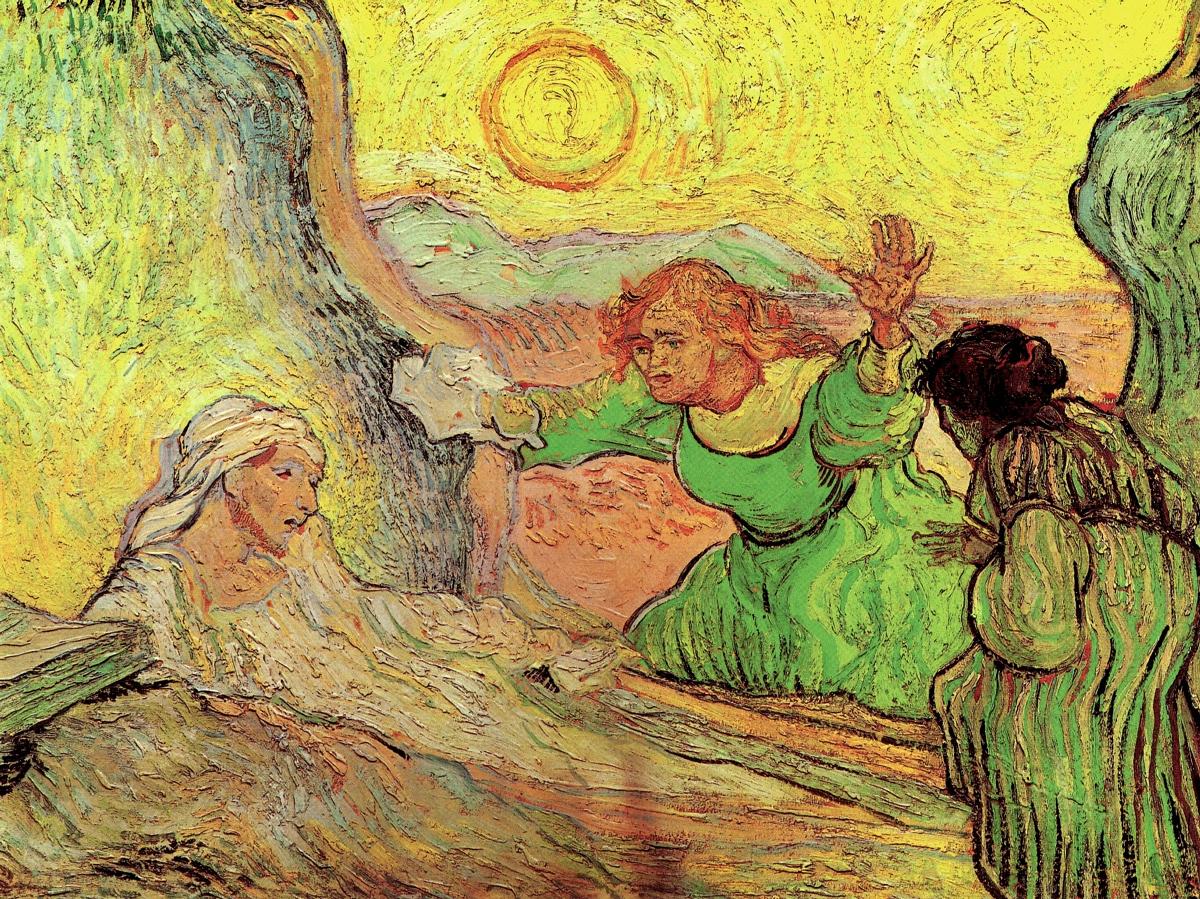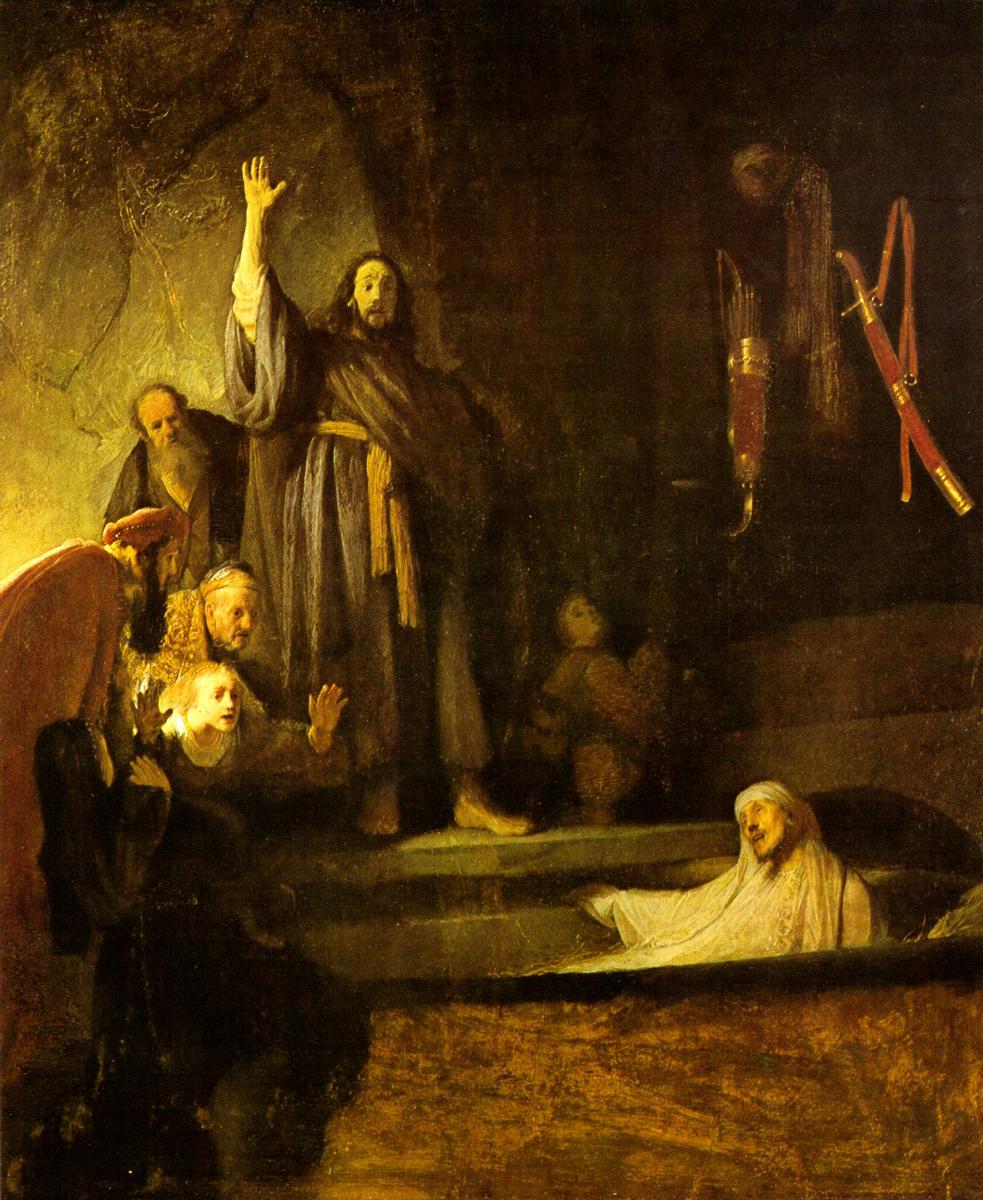April 11: The One Who Gives Life to the Dead
♫ Music:
Friday, April 11—Day 38
Therefore, when Mary came where Jesus was, she saw Him, and fell at His feet, saying to Him, “Lord, if You had been here, my brother would not have died.” When Jesus therefore saw her weeping, and the Jews who came with her also weeping, He was deeply moved in spirit and was troubled, and said, “Where have you laid him?” They said to Him, “Lord, come and see.” Jesus wept. So the Jews were saying, “See how He loved him!” But some of them said, “Could not this man, who opened the eyes of the blind man, have kept this man also from dying?”
So Jesus, again being deeply moved within, came to the tomb. Now it was a cave, and a stone was lying against it. Jesus said, “Remove the stone.” Martha, the sister of the deceased, said to Him, “Lord, by this time there will be a stench, for he has been dead four days.” Jesus *said to her, “Did I not say to you that if you believe, you will see the glory of God?” So they removed the stone. Then Jesus raised His eyes, and said, “Father, I thank You that You have heard Me. I knew that You always hear Me; but because of the people standing around I said it, so that they may believe that You sent Me.” When He had said these things, He cried out with a loud voice, “Lazarus, come forth.” The man who had died came forth, bound hand and foot with wrappings, and his face was wrapped around with a cloth. Jesus said to them, “Unbind him, and let him go.
John 11: 32-44
The One Who Gives Life to the Dead
“Lazarus, come forth.” What strange thing to say to a dead person!
Don’t be mistaken, Lazarus really was dead, not just sick or playing a gag. He was dead, in the tomb, being mourned by his sisters, and even Jesus himself. One minute Jesus is deeply moved, troubled, and weeping over his dead friend and the next he says “remove the stone” and “Lazarus, come forth”.
The reason that Lazarus cannot obey this command is clear. He is dead. He cannot even hear the command. But, when Jesus speaks, something happens: “The man who had died came forth.”
Why? How? The key is that the speaker of these words is no mere human, but God in the flesh. The giver and sustainer of life, who upholds the universe by the word of his power, speaks life into the dead man. When Jesus says “Lazarus, come forth,” the same word that commands this dead man to do the impossible grants him the ability to obey that impossible command. Lazarus really was dead, until the life-producing word of Jesus came to him.
For our music selection, the David Crowder Band performs the familiar hymn “O for a Thousand Tongues to Sing” which contains the following line:
“He Speaks and listening to His voice
New life the dead receive”
This line captures two essential elements to this resurrection story and our two visual artists capture both these elements as well.
1. He Speaks
The first essential element is the fact that Jesus is the one speaking. Rembrandt places Jesus as the focal point of the entire event in his painting. Highlighted and nearly in the middle of the scene, the Christ stands tall with his hand raised up. Lazarus, Mary, and Martha are all in the scene, but the emphasis lands on Jesus, the one “who gives life to the dead and calls into existence the things that do not exist” (Romans 4:17).
2. Listening to His voice, new life the dead receive
The second element to the story, of course, is the effect of these words on Lazarus. Van Gogh, in contrast to Rembrandt, highlights Lazarus and his sisters. In fact, Jesus is not found in his painting at all. He is emphasizing the resurrection in this story, which is a foreshadowing of Jesus’ death and resurrection to come later in the Gospel of John.
Do not fail to notice that Lazarus is painted with a short, red beard. This bearded Lazarus looks a bit like Van Gogh in his self-portraits. This painting helps us to apply this resurrection story. Jesus’ life-giving words take each of us, dead in our sin and trespasses, and shines “in our hearts to give the light of the knowledge of the glory of God in the face of Jesus Christ” (2 Corinthians 4:6).
Jason Oakes, Associate Professor, Talbot School of Theology
Prayer
Lord Jesus, only you give life to the dead. Your word alone accomplishes all that you purpose. You alone have the power to lay down your life and take it up again. Give us your grace so that we can know your love, believe your word, obey your commands, and trust your promises. Amen.
The Raising of Lazarus
Rembrandt van Rijn
Los Angeles County Museum of Art, California
Oil on Panel
And
The Raising of Lazarus (after Rembrandt)
Vincent Van Gogh
Van Gogh Museum, Amsterdam
Oil on Canvas
About the Artist and Art (Piece 1)
Dutch painter, Rembrandt Harmenszoon van Rijn (1606-1669), is considered one of the most prolific artists of all time. His contributions to art came in a period of great wealth and cultural achievement known as the Dutch Golden Age. Rembrandt's greatest creative triumphs are exemplified in the numerous scenes he painted from the Bible. Painted early in his career, The Raising of Lazarus shows the moment Lazarus re-awakens from death and raises out of his tomb as Christ calls him. Lazarus (and another corpse in the background) exists in a darker half of the painting while the other living figures are far more illuminated. Mary and those assembled look on in amazement as Lazarus comes to life. Rembrandt effectively contrasts of light and dark in this painting, with the dark interior of the burial cave and the limited torchlight focusing the attention of the viewer and giving the figures impact.
About the Artist and Art (Piece 2)
Vincent Willem van Gogh (March 1853 – July 1890) was a post-Impressionist painter of Dutch origin whose work, notable for its rough beauty, emotional honesty and bold color, had a far-reaching influence on 20th-century art. This is one of the few paintings by Vincent van Gogh on a biblical theme. It shows Lazarus just after having been risen from the dead. Van Gogh was staying in a mental hospital in Saint-Rémy when he painted this work. It is based on an etching by Rembrandt that his brother Theo had sent him. Van Gogh left Jesus out of the picture and focused on Lazarus and the two sisters. Some think Lazarus' face is a self-portrait, because of the beard. If so, Van Gogh was likely thinking of either his past suicide attempts and subsequent “resurrection” from that state, or was anticipating his own future death and possible resurrection into a less troubled future.
About the Music
O for a Thousand Tongues to Sing Lyrics
Oh, for a thousand tongues to sing
My great Redeemer's praise
The glories of my God and King
The triumphs of His grace
My gracious Master and my God
Assist me to proclaim
To spread through all the earth abroad
The honors of Thy name
So come on and sing out
Let our anthem grow loud
There is one great love
Jesus
Jesus, the name that charms our fears
That bids our sorrows cease
'Tis music in the sinner's ears
'Tis life and health and peace
He breaks the power of canceled sin
He sets the prisoners free
His blood can make the foulest clean
His blood availed for me
He speaks and listening to His voice
New life the dead receive
The mournful broken hearts rejoice
The humble poor believe
Glory to God and praise and love
Be ever, ever giv'n
By saints below and saints above
The church in earth and Heav'n
There are so few words
That never grow old
There are so few words
That never grow old
Jesus
About the Performer
The David Crowder Band was a six-piece Christian rock and modern worship band from Waco, Texas, actively producing music from 1996 – 2012. The band began when Crowder realized that almost half of the students at Baylor University, a Christian university in Texas, were not attending church. Finding this surprising he and Chris Seay started University Baptist Church in 1995, while he was still a student. Crowder became Pastor of worship at the church and began writing songs to incorporate into the worship services he led there. Eventually the church released an independent CD, Pour Over Me, followed by All I Can Say in 1999. These CDs brought the band to a wider audience and invitations to festivals and events followed. The band was signed to sixstepsrecords/Sparrow Records.
http://crowdermusic.com

